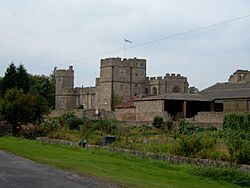Richard Neville, 2nd Baron Latimer facts for kids
Quick facts for kids
Richard Neville, 2nd Baron Latimer
|
|
|---|---|

Snape Castle, seat of the Barons Latimer
|
|
| Born | c.1468 |
| Died | c. 28 December 1530 Snape Castle |
| Buried | Well, North Yorkshire |
| Noble family | House of Neville |
| Spouse(s) | Anne Stafford Margaret (surname unknown) |
| Issue | John Neville, 3rd Baron Latimer William Neville Sir Thomas Neville Marmaduke Neville George Neville, Archdeacon of Carlisle Christopher Neville Margaret Neville Dorothy Neville Elizabeth Neville Katherine Neville Susan Neville Joan Neville |
| Father | Sir Henry Neville |
| Mother | Joan Bourchier |
Richard Neville, 2nd Baron Latimer (around 1468 – December 28, 1530) was an important English soldier and noble. He lived at Snape Castle and fought in major battles like Stoke and Flodden.
Richard Neville was the oldest son of Sir Henry Neville. His father died in 1469 during the Battle of Edgcote. His mother was Joan Bourchier, who passed away in 1470. Richard also had a brother, Thomas, and a sister, Joan.
Richard's grandfather on his father's side was George Neville, 1st Baron Latimer. His grandmother was Elizabeth Beauchamp.
Becoming a Baron
Richard Neville became a baron when he was only about one year old. This happened after his grandfather, George Neville, died in late 1469. Richard inherited lands in many different counties, including Snape Castle in Richmondshire.
In May 1470, his great-uncle, Thomas Bourchier, who was the Archbishop of Canterbury, paid £1000 to become Richard's guardian. This meant he would look after Richard and arrange his marriage. Richard's lands were managed by the King for a while.
Richard was made a Knight of the Bath in January 1478. This was a special honor given by the King.
Public Life and Battles
In 1491, Richard officially took control of his lands. From that year until 1529, he was called to join the English Parliament. This meant he helped make laws and advise the King.
Around 1494, another noble, Robert Willoughby, 1st Baron Willoughby de Broke, tried to claim Richard's title and lands. However, Richard Neville won this dispute and kept his inheritance.
Richard Neville was very loyal to the King. In 1487, he fought in the Battle of Stoke. This battle helped King Henry VII defeat a challenge to his throne. Richard also served in the army in the north of England in 1489. In 1492, he was with the King's forces in France.
In 1499, he was present at the trial of Perkin Warbeck, who claimed to be a lost prince. In 1513, Richard fought bravely in the Battle of Flodden. He was part of the front line of the army. In 1522, he was asked for advice about a possible war.
Richard also helped the country in non-military ways. He was part of several important groups that advised the King. He attended royal parties in 1488 and 1499. In 1503, he helped escort King Henry VII's daughter, Margaret Tudor, on her journey to Scotland to marry James IV. In 1515, he was at a special ceremony where Thomas Wolsey became a Cardinal.
In 1530, Richard Neville signed a letter asking Pope Clement VII to allow King Henry VIII to divorce his wife, Catherine of Aragon. Richard died shortly after, in December 1530, at Snape Castle. He was buried with his first wife, Anne Stafford, in the church at Well, North Yorkshire.
Family Life
Richard Neville married his first wife, Anne Stafford, around 1490. Anne was the daughter of Sir Humphrey Stafford. Richard and Anne had six sons and six daughters:
- John Neville, 3rd Baron Latimer: He married three times. His third wife was Catherine Parr, who later became King Henry VIII's sixth Queen.
- William Neville: He was born in 1497 and was a writer. He married Elizabeth Greville.
- Sir Thomas Neville: He lived in Essex and married Mary Teye.
- Marmaduke Neville: He also lived in Essex and married Elizabeth Teye.
- George Neville: Born in 1509, he became a church official called the Archdeacon of Carlisle.
- Christopher Neville.
- Margaret Neville: Born in 1495, she was the oldest daughter. She married Edward Willoughby and later Sir William Gascoigne.
- Dorothy Neville: She married John Dawnay.
- Elizabeth Neville: Born in 1500, she married Sir Christopher Danby. They had many children.
- Katherine Neville.
- Susan Neville: Born in 1501, she married Richard Norton.
- Joan Neville.
Richard Neville married a second time in 1502 to Margaret Danby. Margaret was the widow of Sir James Strangways.

